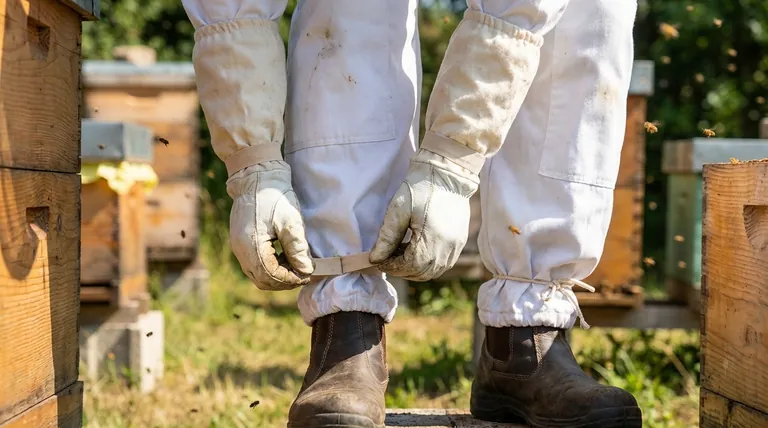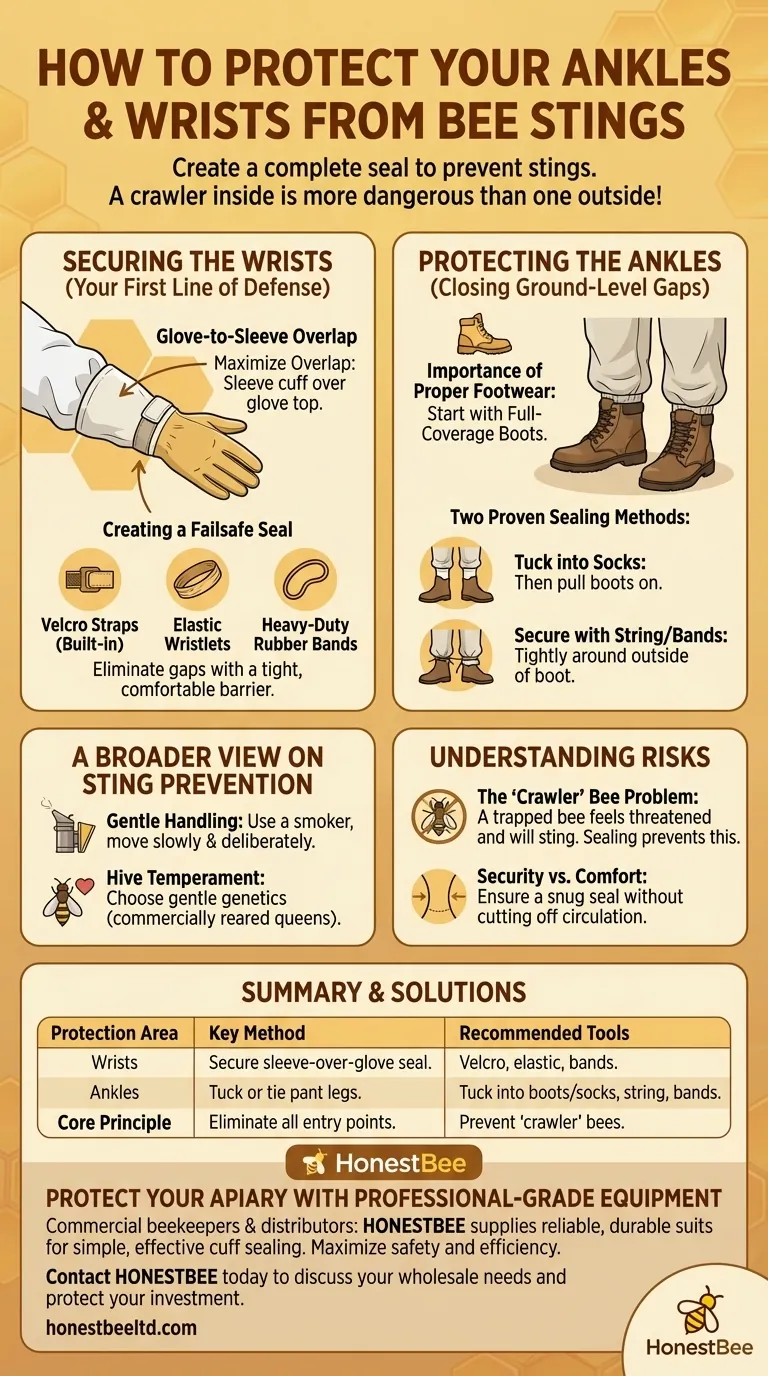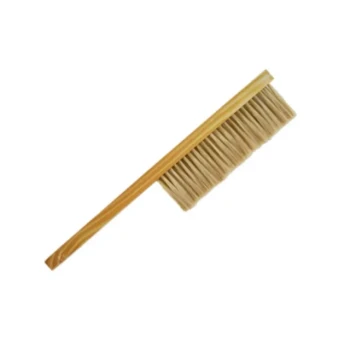To effectively protect your ankles and wrists from stings, you must create a complete seal at the cuffs of your bee suit. For ankles, this involves tucking your pant legs securely into your boots or socks, or using rubber bands or string to tighten them. For wrists, sleeves should be secured over your gloves using Velcro straps, elastic wristlets, or rubber bands to eliminate any gaps.
The core principle is not just to cover the skin, but to eliminate all potential entry points. A single bee that crawls inside your suit is far more likely to sting than one on the outside, making secure seals at the wrists and ankles a critical element of beekeeper safety.

Securing the Wrists: Your First Line of Defense
Your hands and arms are in constant motion around the hive, making your wrists a primary target for curious or defensive bees. A proper seal here is non-negotiable.
The Glove-to-Sleeve Overlap
Most beekeeping gloves extend well past the wrist. The goal is to create a significant overlap between the cuff of your suit's sleeve and the top of the glove. This overlap is your first layer of protection.
Creating a Failsafe Seal
Even with an overlap, movement can create gaps. You must actively secure the sleeve over the glove.
Effective methods include using Velcro straps (often built into bee suits), dedicated elastic wristlets, or simple, heavy-duty rubber bands. This creates a tight but comfortable barrier that a bee cannot bypass.
Protecting the Ankles: Closing the Ground-Level Gaps
Bees can easily crawl up from the ground or fall from a frame and land near your feet. An unsealed pant leg is an open invitation for them to explore upwards.
The Importance of Proper Footwear
Start with boots that fully cover your ankles. Standard work boots, rubber boots, or high-top shoes are significantly better than low-cut footwear.
Two Proven Sealing Methods
The most common and effective techniques involve either tucking or tying.
You can tuck your pant legs directly into your socks and then pull your boots on over them. Alternatively, you can pull your pant legs down over your boots and then secure them tightly with string or rubber bands around the outside of the boot.
Understanding the Trade-offs and Risks
Simply wearing a suit is not enough. Understanding why these specific areas are so vulnerable is key to staying safe and confident.
The "Crawler" Bee Problem
A bee flying around you is often just investigating. However, a bee that gets trapped inside your clothing feels threatened and is almost certain to sting. Sealing your wrists and ankles prevents this "crawler" scenario entirely.
Security vs. Comfort
While a tight seal is essential, ensure it does not cut off circulation. Your straps or bands should be snug, not painfully tight. Modern bee suits with built-in elastic cuffs often provide the best balance of security and comfort.
A Broader View on Sting Prevention
While physical barriers are your last line of defense, your actions and equipment can dramatically reduce the likelihood of bees even attempting to sting.
Gentle Handling is Key
Your behavior has a direct impact on the bees' defensiveness. Always use a smoker to calm the colony and handle all movements slowly and deliberately. Quick, jerky motions can be interpreted as a threat.
Hive Temperament Matters
The genetics of your colony play a significant role. Working with bees that have been bred for gentle traits, often from commercially reared queens, can make hive inspections a much calmer experience for everyone involved.
Making the Right Choice for Your Goal
Your approach to securing your suit should match your comfort level and the temperament of your hives.
- If your primary focus is maximum security: Use multiple layers. Tuck your pants into your socks, pull your boots on, and then use an additional strap or rubber band around the outside of the boot.
- If your primary focus is convenience: Choose a bee suit with high-quality, built-in elastic at both the wrists and ankles, and pair it with tall, pull-on boots.
- If you are working with a very gentle hive: You may feel comfortable with a simpler tuck or a single rubber band, but never neglect to seal these critical entry points.
Ultimately, a completely sealed suit is the foundation of confident and safe beekeeping.
Summary Table:
| Protection Area | Key Method | Recommended Tools |
|---|---|---|
| Wrists | Create a secure sleeve-over-glove seal. | Velcro straps, elastic wristlets, rubber bands. |
| Ankles | Tuck or tie pant legs to eliminate gaps. | Tuck into boots/socks, use string or rubber bands. |
| Core Principle | Eliminate all potential entry points to prevent 'crawler' bees from getting inside the suit. |
Protect Your Apiary with Professional-Grade Equipment
Are you a commercial beekeeper or equipment distributor looking for reliable, durable suits and protective gear that make sealing cuffs simple and effective? HONESTBEE supplies high-quality beekeeping supplies and equipment designed for the demands of professional apiaries.
We help you maximize safety and efficiency, ensuring your team can work confidently and productively. Contact HONESTBEE today to discuss your wholesale needs and discover how our equipment can protect your investment.
Visual Guide

Related Products
- Cotton Beekeeping Suit and Round Hat with Veil Bee Keeper Protective Gear
- White Beekeeping Protective Suit and Hat with Fencing Veil for Beekeepers
- Professional Beekeeping Suit for Kids and Girls Childrens Bee Keeper Suit
- Heavy Duty Cowboy Beekeeper Hat with Visibility Veil Outdoor Professional Beekeeping Protective Gear
- Beekeeper Cowboy Hat and Veil for Beekeeping
People Also Ask
- Why is a jacket with a hat veil recommended for beekeepers? Essential Protection for Your Face and Neck
- What factors should be considered when choosing a beekeeping suit? Balance Safety, Comfort & Performance
- What are the benefits of a fully ventilated beekeeping suit? Stay Cool and Protected in Hot Climates
- How should a beekeeping suit be hung to maintain its shape? Protect Your Investment with Proper Storage
- What should be considered regarding the color of beekeeping clothing? Ensure Your Safety and Keep Bees Calm



















